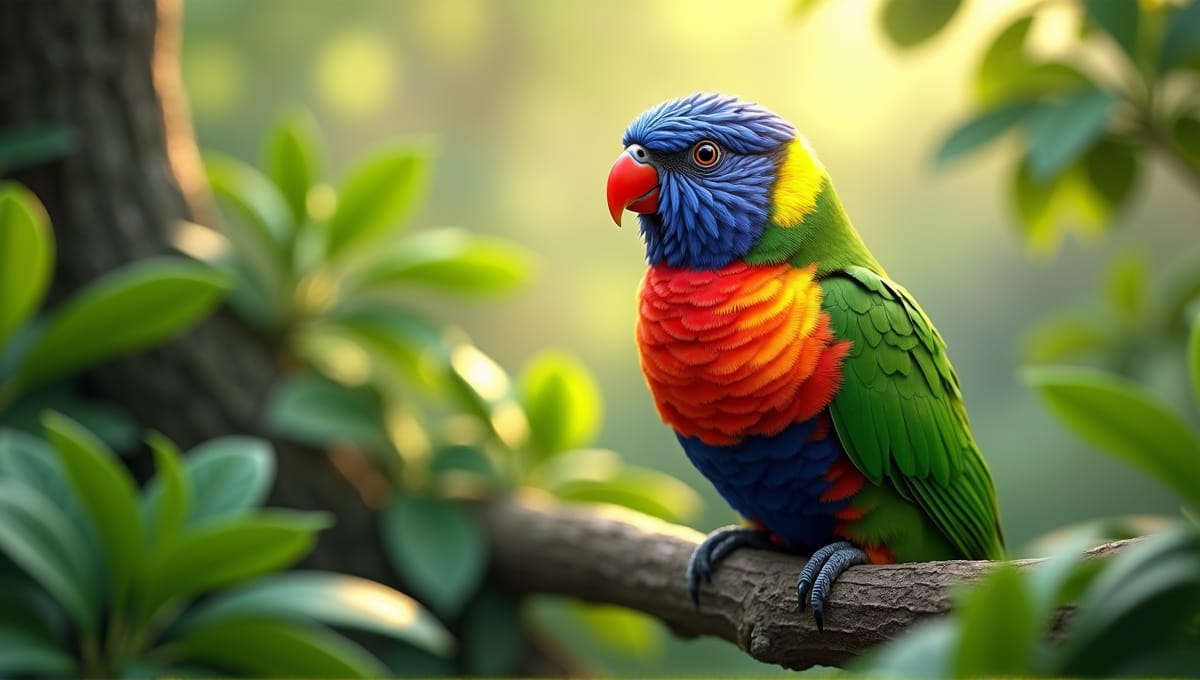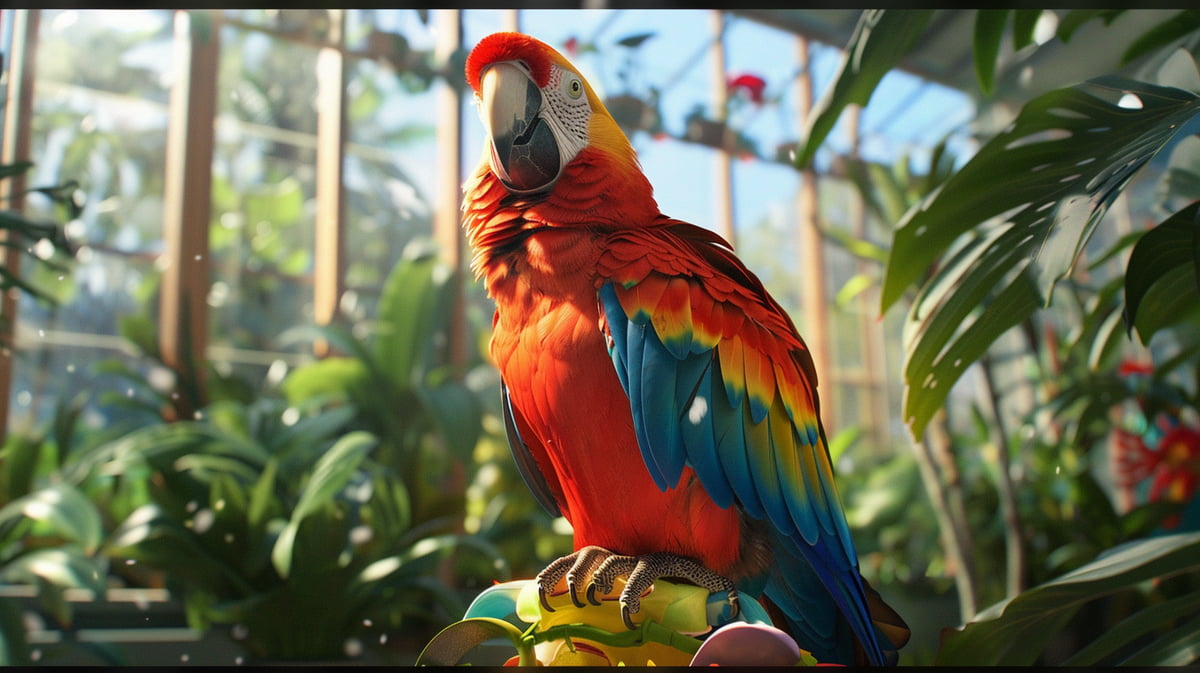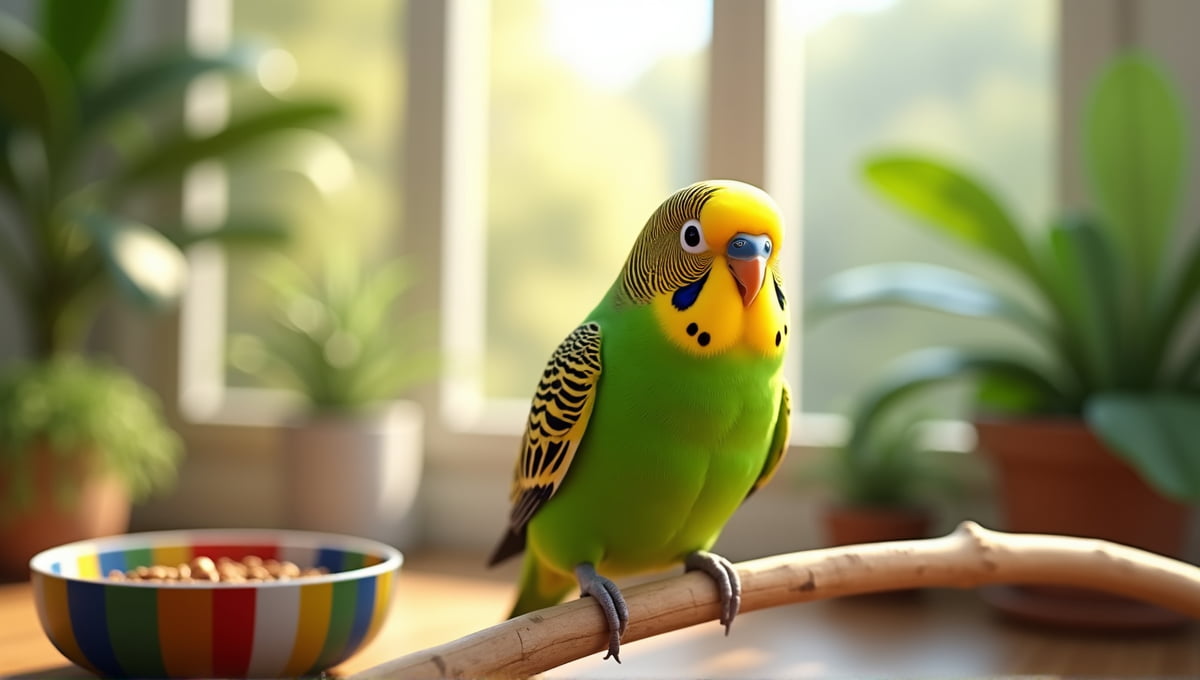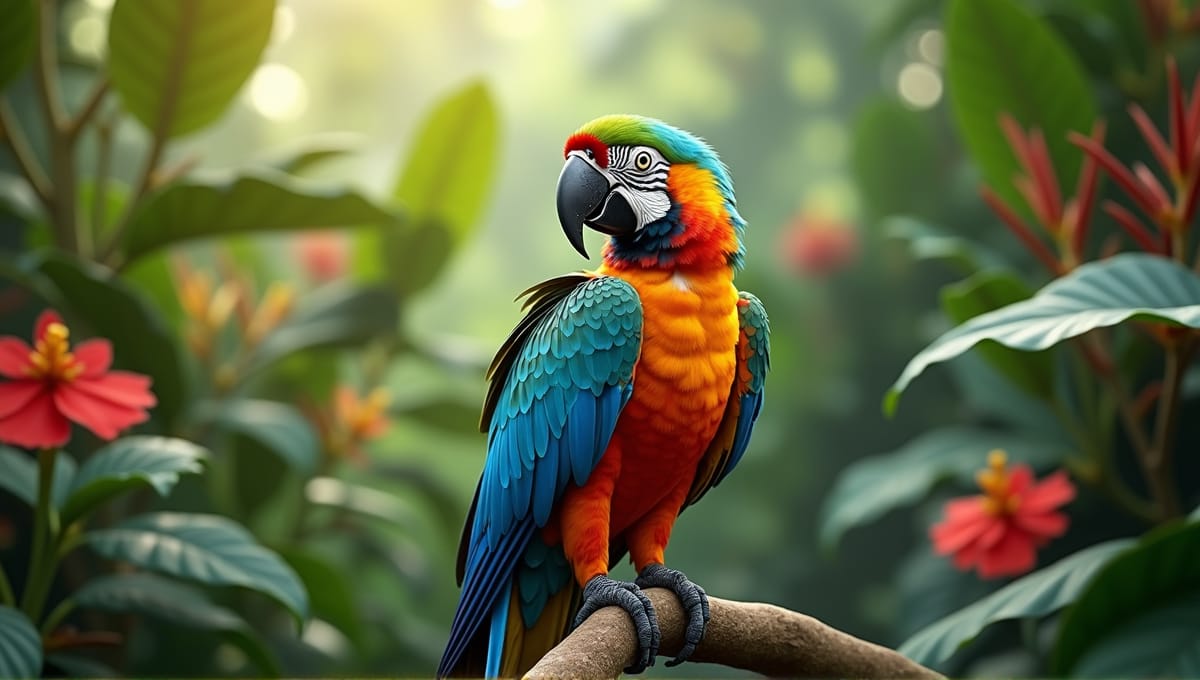As a ornithologist who has spent years researching bird behavior, I’m very familiar with parrot flight. Most pet parrots don’t fly very well because they have little space to fly and don’t exercise. Can you help your parrot fly better? Yes! With the right training and environment, pet parrots can develop stronger flight muscles and flight skills. So, how can you help your bird maximize its natural flying abilities?
Parrot Flight Mechanics and Wing Structure

Parrots are amazing flyers. Their wing anatomy is a natural engineering marvel built for agility and precision. The pectoralis major and supracoracoideus muscles are the primary muscles that power a parrot’s flight. These two muscles account for about 25% of the parrot’s total body weight.
Parrot wings have a unique shape. They are broader and more rounded compared to other bird species, allowing them to take off and land quickly and to have great agility in flight. The Wing to Body Ratio varies by species of parrot. Larger parrots like macaws have a lower Wing to Body Ratio, whereas smaller parrots like budgies have a higher Wing to Body Ratio. This impacts their flying style and what they are designed to do in the wild.
The structure of a parrot’s feathers is also key to their flight ability. They have strong flight feathers with interlocking barbules. These barbules create a flat surface that allows air to flow efficiently over the wing. They have great contour feathers that help shape the wing to generate optimal lift.
Here’s how the parrot’s wing compares to other birds:
| Feature | Parrots | Eagles | Hummingbirds |
|---|---|---|---|
| Wing Shape | Broad and rounded | Long and narrow | Short and stubby |
| Primary Function | Maneuverability | Gliding | Hovering |
| Feather Density | High | Medium | Very High |
| Wing Loading | Medium | Low | High |
These wing shapes combined with feather density and wing loading make parrots very versatile flyers. They can fly through thick forest or open spaces with ease. Understanding parrot anatomy is crucial to appreciating their flying abilities.
Flight Capabilities of Different Parrot Species
Flight capabilities can vary significantly among parrots. Factors such as size, weight, and wing shape all contribute to a parrot’s flight abilities. Some parrots are designed for long-distance flight, while others are designed for quick, short bursts of flight.
Larger parrots (e.g., macaws) have the muscle strength to fly long distances, though they aren’t as agile as smaller species. Conversely, smaller parrots (e.g., cockatiels, budgerigars) are very agile flyers and can execute many aerial maneuvers with ease.
Parrots that live in forests have wings designed for quick, short flights through dense vegetation. When you see a parrot with longer wings, it’s designed for long distance flight in more open habitats (e.g., cockatoos).
Some parrot species are particularly notable for their flying abilities:
- Swift Parrot: Flies over 2,000 km during migration
- African Grey Parrot: Flies at high altitudes up to 3,000 meters
- Hyacinth Macaw: Impressive speed for its size due to strong flight muscles
- Budgerigar: Excellent at doing aerial acrobatics
- Eclectus Parrot: Strong flyer with excellent endurance
These differences illustrate the range of flight adaptations that exist within the parrot family. Each species has evolved to thrive in a specific environment and lifestyle.
Parrot Flight Patterns and Behaviors

Parrots have some interesting flight styles. I’ve seen various flight styles while conducting research. Most parrots fly directly with rapid wing beats in flight. This is an efficient way to quickly fly from one perch or tree to another.
Many parrot species also engage in flock flying. This is another common flight style. Flocking provides safety in numbers and allows the lead bird to create an air current that following birds can utilize, making flight more efficient.
Vocal communication is an important aspect of parrot flight behavior. Most parrot species have distinct flight calls that help the flock stay together and communicate intentions.
Parrots are excellent at aerial acrobatics. You’ll see them doing loops, rolls, and quick changes of direction while flying. While these behaviors may look entertaining, they serve practical purposes. Parrots use these maneuvers to escape predators and navigate through cluttered environments.
Flight behavior also changes throughout the season. During the breeding season, you may see parrots doing courtship flights. Some parrot species even engage in seasonal migrations, which is impressive considering their small body size.
Finally, flight is also a social behavior for parrots. They use flight to show dominance, attract a mate, or simply play. This is a good reminder that flight is more than just a mode of transportation for parrots. These behaviors are closely tied to parrot personalities, which can vary greatly between species and individuals.
Flight Speed and Distance Capabilities
Parrot flight speed differs from species to species. Here are the average flight speeds for some of the most common parrot species:
| Species | Average Flight Speed (mph) |
|---|---|
| Macaw | 35-50 |
| African Grey | 40-45 |
| Cockatiel | 25-30 |
| Budgerigar | 20-25 |
| Amazon Parrot | 30-35 |
Flight speeds can also be influenced by wind conditions, terrain, and the bird’s motivation for flying (e.g., is the bird flying for fun, exercise, etc.).
Some parrot species can fly impressive distances. For example, the swift parrot migrates over 2,000 km (1,200 miles), and amazons and macaws regularly fly 15-20 km (about 10 miles) each day in search of food.
Flying is energetically expensive, and parrots have evolved several clever tricks to minimize the energy cost of flying. For example, they are adept at using thermals and wind currents for lift and can often cover long distances with little to no muscle-powered flapping.
The ability to navigate during a long flight is a visually impressive feat. Parrots likely use a combination of visual landmarks, Earth’s magnetic fields, and celestial cues to maintain their bearings for the duration of a flight. The parrot lifespan can be quite long, allowing them to develop and refine these impressive navigation skills over many years.
Encouraging Healthy Flight in Pet Parrots
Flight is essential for a parrot’s physical and mental health. It allows them to get exercise, build muscle, and keep their mind active. As a parrot owner, you can help ensure healthy flight patterns.
One of the most important steps you can take is creating a safe flight environment. This means removing any potential dangers, such as ceiling fans or open doors. You should also provide an adequate space for your parrot to fly. The minimum recommended space for flying is 15-20 feet long with an 8-foot ceiling.
Climate also influences your parrot’s ability to fly. The ideal temperature range for parrot flight is 70-80°F (21-27°C). Therefore, keep the temperature in your home within this range. If it’s too cold, your parrot won’t be motivated to fly.
Toys and perches can also encourage activity. Install perches at different heights, so your parrot has to fly to each one. You can also select toys that require your parrot to fly in order to access them. Choosing the right pet bird toys can greatly enhance your parrot’s flying experience and overall well-being.
Diet is another key factor in supporting flight muscles. Your parrot needs enough protein and complex carbs to have energy for flight. For specific diet advice, talk to an avian veterinarian.
Flight Training for Pet Parrots
Flight training is very beneficial for captive parrots. It helps them stay physically fit, enhances their cognitive function, and reduces stress. Adult parrots can learn to fly, and the success rate is about 80%.
You can use basic flight training concepts with parrots:
- Fly short distances between perches.
- Use positive reinforcement (treats and praise).
- Gradually increase the distance and difficulty of the flights.
- Do some recall flights to establish trust and compliance.
- Set up obstacles for more advanced flights.
How many times you train is more important than how long you train. Shoot for 2-3 training sessions per day, each lasting 10-15 minutes. Consistency is the only way to see results.
On average, it takes a parrot 3-6 months to become a proficient flier. However, this depends on the individual bird and how consistently you train.
Common flight training challenges include birds being afraid of heights or new environments. To work through these challenges, be patient and use incremental exposure. Some parrots may also be reluctant to leave their cage, which you can resolve by giving them regular out-of-cage time to boost their confidence.
Flight Exercise Requirements for Parrots
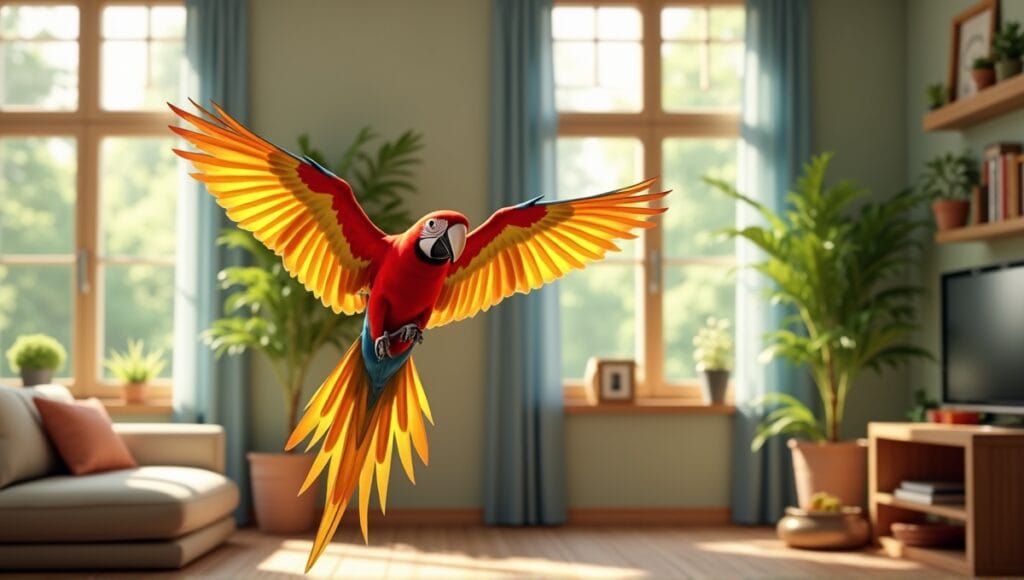
Daily flight exercise is essential for pet parrots. Aim for a minimum of 30 minutes of flight time each day. You can break this into shorter sessions throughout the day.
It takes time to build flight muscles. Most birds require consistent training for 4-8 weeks to see significant improvements. Begin slowly and gradually increase the duration and intensity.
There are a variety of flight exercises you can do with your parrot:
- Recall flights to different family members
- Obstacle course flights through perches and toys
- Foraging flights to find hidden treats
- Freefly time in a secure, enclosed area
Although flight is the most important physical exercise, climbing, foraging, socialization, and puzzle-solving are also important to ensure your parrot is getting a well-rounded life.
Watch your parrot’s flying stamina. You should see improvements in endurance and flight skills. If you see your parrot breathing heavily, wings drooping, or showing any hesitation to fly, it’s time to end the session.
Exhausting your bird is dangerous. If you notice any labored breathing, excessive panting, or inability to perch steadily after exercise, you’ve pushed your bird too hard. If any of these signs persist, lower the intensity of the exercise and don’t be afraid to ask an avian veterinarian if you have any concerns.
For those new to parrot ownership, understanding these flight requirements is crucial. If you’re considering getting a parrot, it’s important to research pet birds for beginners to ensure you can meet their flight and exercise needs.
Parting Thoughts
Parrots are excellent flyers and have evolved some interesting adaptations. Their wing structure, flight styles, and capabilities differ significantly from one species to another. For pet parrots, flight is essential for their overall health and happiness. Y
You can encourage your parrot to build strong flight muscles by providing a safe environment and using effective training methods. Then, the key to success is ensuring they receive regular exercise. You can achieve great results if you’re patient and consistent as your feathered friend will be much better off both physically and mentally.



